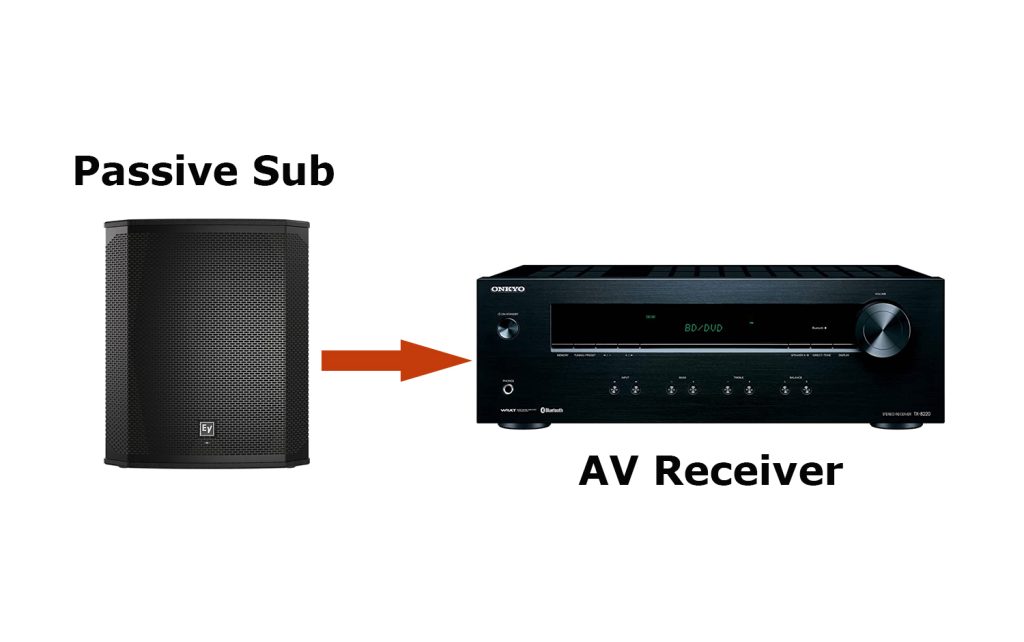
The Subwoofer is the speaker of choice when it comes to enjoying those deep, rumbling bass sounds. But before that, you’ll need to figure out how to connect it to your home theater system. And if you’ve purchased a passive subwoofer, it can be quite confusing.
The best way to connect a passive subwoofer to a receiver is to use an external amplifier as an intermediary. First, connect it to an external amp, then connect the amp to the receiver.

Alternatively, you could connect the subwoofer directly to your receiver through speaker connectors, but the quality won’t be optimal.
Before we go into the details of why it’s better to use an external amplifier to connect a passive subwoofer to a receiver rather than connect it directly, let’s first understand how a passive subwoofer works and how it is different from a powered subwoofer.
One of the key components of a home theater audio system, the subwoofer specializes in delivering lower-frequency sounds ranging between 20-200 Hz.
Subwoofers come in two categories- passive and powered. While powered or active subwoofers include an internal amplifier, passive subwoofers don’t. Therefore passive subwoofers need to be powered by an external amplifier.
You can tell if your subwoofer is passive if it does not have a subwoofer line input and only has speaker connections. Since it does not house an in-built amplifier, it will also be lighter than a powered subwoofer which has an amplifier integrated into the same enclosure.
There are two methods to connect a passive subwoofer to a receiver.
The first method is to connect it via an external amplifier. This essentially makes your passive subwoofer function like a powered subwoofer.
Step 1- Power off your devices and disconnect them from the power source before you start.
Step 2- Connect the subwoofer line outputs of the receiver to the line inputs of the external amplifier.
Step 3- Finally, connect the speaker outputs on the amplifier to the speaker ports on the passive subwoofer.
The second method is to treat the passive subwoofer as a traditional loudspeaker and use the speaker connectors to connect it directly to your receiver. For this to work, you need to change your receiver settings.
Since subwoofers are designed to deliver low-frequency sounds, they need a lot of power. If you connect the passive subwoofer directly to the receiver, you may not get the optimum quality of bass sounds.
Moreover, there is a risk the subwoofer may be too powerful for the receiver to handle and might end up draining its power supply.
Therefore, it is better to connect your passive subwoofer to an intermediary amplifier to prevent it from draining power from your receiver. You’ll also get much better audio quality this way.
Passive subwoofers are generally used in custom installations. They are preferred by many home theater designers for large rooms that require multiple units. The advantage of this type of modular unit is that any component can be easily replaced if something goes wrong with it.
Audiophiles sometimes prefer these passive subwoofers because they get more control over every variable such as wiring, amplification power, crossover points, etc
Passive subwoofers are more lightweight and can be mounted on a wall as well.
They also require less power compared to powered subwoofers. They are a great option if you need to connect multiple subwoofers to spread the bass evenly in your home theater room.
Opting for a passive subwoofer might end up being more expensive since you have to factor in the cost of the external amplifier.
It’s much more complicated to connect and requires more wiring.
Powered subwoofers are self-contained units that include built-in amplifiers. The advantage of having the amplifier integrated with the unit is that the subwoofer and the amplifier will be optimally matched.
Installation too is easy. All you need is a single cable connection to plug it into the receiver. This relieves the power load of the receiver and allows the receiver’s own amplifier to power the mid-range and tweeter speakers with ease.
Powered subwoofers are also great for homes that require only one subwoofer. These compact units make for a neater home theater setup.
A powered subwoofer is more expensive than a passive subwoofer. It uses more power and will increase your energy costs.
Also, it requires your receiver to have a pre-out port.
While powered subwoofers are more popular since they are compact and easier to install, it is not the type of subwoofer that determines which is better. The quality depends more on the brand and model that you choose and which type is more suited to your individual needs.
However, as far as convenience is concerned, powered subwoofers have an edge. Easy to set up, they are great for beginners who don’t want to struggle with too many technical details such as amplifier-subwoofer matching or crossover points, etc.
As far as cost is concerned, although they are more expensive, if you consider the fact that you would need to also buy an amplifier for a passive subwoofer- the overall cost basically evens out.
If you have already bought a passive subwoofer, the best way would be to connect it to a receiver via an amplifier to avoid blowing out your gear.
However, if you are new to home theater audio and you have not yet purchased your subwoofer, we recommend you first check if your receiver has a subwoofer preamp output. If it does, opting for a powered subwoofer would make your setup much easier.